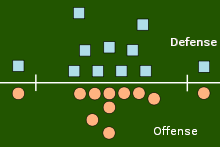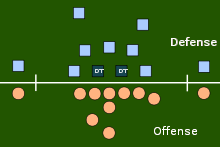4–3 defense

In American football, a 4–3 defense is a defensive alignment consisting of four down linemen and three linebackers. It is probably the most commonly used defense in modern American football and especially in the National Football League.[citation needed] NFL teams that use the 4–3 defense as of 2013 include the Dallas Cowboys, Atlanta Falcons, Oakland Raiders, Minnesota Vikings, Chicago Bears, Carolina Panthers, Denver Broncos,New Orleans Saints, Cincinnati Bengals, Jacksonville Jaguars, St. Louis Rams, Detroit Lions, New England Patriots, Tampa Bay Buccaneers, Seattle Seahawks, Miami Dolphins and the New York Giants. The Broncos returned to the 4–3 with the hiring of John Fox as head coach. The Patriots returned to the 4–3 in the 2011 NFL Season. The New York Jets used variations of the 4–3 for the 2012 NFL Season against spread offenses, but will stick with the 3-4 defense as its base. The Cowboys will return to a 4–3 Defense with the hiring of Monte Kiffin as their Defensive Coordinator. The Bills will not have base defense with new Defensive Coordinator Mike Pettine, who came over from the Jets, where they ran a 3–4 defense. However, the Bills ran a 4–3 Defense in 2012, so it remains to be seen what the TV will show. Early in training camp, indications point to the Bills using a 3-4 Defense with Mario Williams at OLB.
The invention of the 4–3 is often attributed to legendary coach Tom Landry, in the 1950s, while serving as the defensive coordinator of the New York Giants, in large part because the Giants were the first to adopt the 4-3 as their base defense.[1] Others attribute the creation of the 4–3 to Chicago Bears Hall of Fame linebacker, Bill George.[2] It has also been said that the 4–3 defense was a creation of Garrard "Buster" Ramsey, the defensive coach of the Detroit Lions teams in the 1950s.[3]
In the original version of the 4–3, the tackles lined up over the offensive guards and the ends lined up on the outside shoulder of the offensive tackles, with the middle linebacker over the center and the other linebackers outside the ends. In the mid-1960s Hank Stram developed a popular variation, the "Kansas City Stack", which shifted the strong side defensive end over the tight end, stacked the strongside linebacker over the tackle, and shifted the weakside tackle over center. At about the same time the Cleveland Browns frequently used a weakside shift. The Dallas Cowboys coach Tom Landry developed a "flex" variation, in order to take advantage of the quickness of his Hall of Fame tackle, Bob Lilly.[4] In Tom Landry's original 4–3 defenses (4-3 Inside and 4-3 Outside), both defensive tackle were flexed.[5] In the "flex", on a pro set right, with defensive keys showing a run to the right, the right defensive tackle would be flush on the line and was supposed to penetrate.[6] The right defensive end and left defensive tackle were flexed two feet off the line of scrimmage, the right defensive end now head on with the left offensive tackle (i.e. a 4-2-2-5 front instead of the more common 5-2-2-5 front). This gave the defense a "zig zag" look unlike any other of its day. More modern versions of the 4-3 include the Tampa 2 scheme and the 4-3 slide.

Defensive Line

There are two defensive tackles in the 4–3 scheme. Teams whose base front is an "over" or "under" front will have a nose tackle in this scheme. In schemes whose base set is an even 4–3, there is no nose tackle. Instead there is a left and right defensive tackle. When teams don't have a nose tackle, the tackles line up face on the offensive guards. The nose tackle is generally slightly larger and stronger and plays a shade or head-up technique which means he lines up on either outside shoulder of the center or in the middle of his body depending on which way the strength of the play is going. The nose tackle's primary job is to stop the run and take on the double team (which is getting blocked by both the center and the weak-side or pulling guard) thus freeing up the linebackers to make a play. The second defensive tackle (simply referred to as the defensive tackle, under tackle or three tech) is generally a bit quicker and faster than the nose tackle, ideally weighing close to 300 pounds (140 kg) but quick-footed enough to shoot through a gap at the snap.[7] He plays a three technique meaning he lines up on the outside shoulder of the strong side offensive guard. The job of a three tech is to: prevent the run, keep the guard off linebackers, and rush the quarterback on pass plays.

- Defensive Ends
| “ | Teams that want to use a standard 4–3 scheme often face a dilemma: there aren't enough great defensive ends to go around. Players like Julius Peppers or Jevon Kearse come along about once per year in the draft. | ” |
| —Mike Tanier, analyst for NFL on Fox.[7] | ||
The defensive end's primary role in the 4–3 defense is to get to the quarterback and create pressure. The 4–3 DE's are the smallest of all of the defensive lineman due to their emphasis of speed over strength. They still need to be strong enough to fight their way past offensive tackles, yet quick enough to pursue the running backs on runs to the outside. Ideal 4–3 defensive ends are athletic and agile and their strength is getting up the field quickly and they usually weigh between 260 and 275 pounds (118 and 125 kg).[8] Right ends, who line up against the offensive left tackle and attack from the blind side of a right-handed quarterback, are usually the best athletes on the line, combining a 275-pound body with incredible quickness and agility to outflank blockers who are bigger and heavier.[7] Defensive ends generally play the 1 gap technique, though will occasionally be forced to play a 2 gap in the event of a TE pinching in to block on run plays. In most schemes, they are also responsible for keeping the quarterback from rolling out of the pocket to make big running gains.
- Variant
Some teams like the Seattle Seahawks, Denver Broncos, Cincinnati Bengals and Oakland Raiders use an alternative sort of the 4–3 defense. They like to use a big, strong, 290 and plus strongside defensive end to stop the run on their base formation, and on passing downs they kick inside at defensive tackle to insert a pass rush specialist. But, players like Von Miller and James Harrison, two elite and undersized defensive ends, play strongside linebacker on 1st and 2nd downs and use their pass rushing ability on passing downs by lining up at stand-up defensive end to bring pressure on the quarterback.
Linebackers

- Middle Linebacker
There is only one inside linebacker in the 4–3 scheme, so he is called the Middle linebacker (MLB), sometimes known as the “Mike” linebacker. He must be as smart as he is athletic, acts as the “quarterback of the defense” and is often the defensive leader.[7] The primary responsibility of the “Mike” is to stop the run, though he will often be asked to fall back in zone coverage in pass protection; man to man pass coverage has him assigned to the fullback typically. The MLB is often the largest and strongest of all of the linebackers.
The 4–3 defense relies on having a sure tackler at the middle linebacker spot. Most notably, Monte Kiffin's “Tampa Cover 2” scheme makes high demands on the MLB, requiring him to have above-average speed, and additional skills to be able to read the play and either maintain his central position to help the outside linebackers cover short passes, drop behind the linebackers in coverage and protect the zone of the field behind the outside linebackers from 11–20 yards out, or run up to the line of scrimmage to help assist in stopping the runs.[9]
- Outside Linebackers
As in the 3–4 defense there are two outside linebackers in the 4–3. These outside backers are known as the Strong-Side and Weak-Side Linebackers. The Strong-Side, or “Sam” linebacker, is so named because he typically sticks to the strong side of the defense, across from the TE. The “Sam” does his fair share of blitzing, however he also needs to play the run and take on blockers, making him a bigger linebacker on average than the Weak-Side linebacker. He will usually be relied upon to cover the tight end or potentially a back out of the backfield.[10] Daryl Smith is a prototypical Sam linebacker. The Weak-Side, or “Will” linebacker, will generally play on the weak side and has more freedom than the other LBs, often blitzing the QB or guarding against the screen. He also has heavy coverage responsibilities, making a good number of today's Will linebackers former safeties.[11] Jerod Mayo is a prototypical Will linebacker.
Secondary
The 4–3 defense generally uses four defensive backs. Two of these are safeties, and two of them are cornerbacks. A cornerback's responsibilities vary depending on the type of coverage called.
Coverage is simply how the defense will be protecting against the pass. The corners will generally line up 3 to 5 yards off the line of scrimmage, generally trying to "Jam" or interrupt the receivers route within the first 5 yards. A corner will be given one of two ways to defend the pass (with variations that result in more or less the same responsibilities): zone and man-to-man. In zone coverage, the cornerback is responsible for an area on the field. In this case, the corner must always stay downfield of whomever it is covering while still remaining in its zone. Zone is a more relaxed defensive scheme meant to provide more awareness across the defensive secondary while sacrificing tight coverage. As such, the corner in this case would be responsible for making sure nobody gets outside of him, always, or downfield of him, in cases where there is no deep safety help. In man coverage, however, the cornerback is solely responsible for the man across from him, usually the offensive player split farthest out.
The free safety is responsible for reading the offensive plays and covering deep passes. Depending on the defensive call, he may also provide run support. He is positioned 10 to 15 yards behind the line of scrimmage, toward the center of the field. He provides the last line of defense against running backs and receivers who get past the linebackers and cornerbacks. He must be a quick and smart player, capable of making tackles efficiently as well as reading the play and alerting his team of game situations. The strong safety is usually larger than the free safety and is positioned relatively close to the line of scrimmage. He is often an integral part of the run defense, but is also responsible for defending against a pass; especially against passes to the tight-ends.
References
- ↑ Zimmerman, p. 128.
- ↑ from http://www.profootballhof.com/hof/member.jsp?player_id=73, March 20, 2007.
- ↑ Piascik, Chapter 11.
- ↑ Golenbock, p. 233
- ↑ Lombardi, pp. 173-185
- ↑ Golenbock, pp. 232-240.
- ↑ 7.0 7.1 7.2 7.3 Tanier, Mike (2006-08-28). "The 4–3 vs. the 3–4". NFL on Fox.
- ↑ Smith, Michael (2004-12-15). "Defensive linemen do the dirty work in 3-4". ESPN.com.
- ↑ Mullen, Bryan (2008-12-15). "Kiffin's dad enjoys sterling reputation". The Tennessean.
- ↑ http://bleacherreport.com/articles/1212418-football-101-linebacker-assignments-and-alignment
- ↑ http://football.calsci.com/Positions9.html
Bibliography
Lombardi, Vince, "Vince Lombardi on Football", New York Graphic Society, 1973.
Golenbock, Peter, "Cowboys Have Always Been my Heroes", Warner Books, 1997, Chapter 20.
Zimmerman, Paul, "The New Thinking Man's Guide to Pro Football", Simon and Schuster, 1984, Chapter 6.
Piascik, Andy, The Best Show in Football: The 1946-1955 Cleveland Browns – Pro Football’s Greatest Dynasty, Taylor Trade Publishing, 2006 [ebook]
| |||||||||||||||||||||||||||